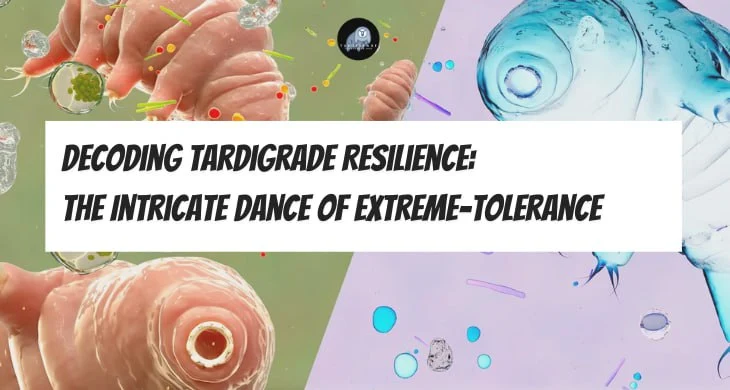Scientists are quite surprised by tardigrades, usually known as water bears, because of their special capacity to fight harsh surroundings. Although they were formerly classified as extremophiles, a fresh study indicates that a more accurate term for them would be extreme-tolerant. The key to their survival lies in a mysterious state called tun, where these tiny creatures enter deep hibernation to fight external stressors. In this blog, we will learn about the recent findings that exfoliate light on the molecular mechanisms behind tardigrade adaptability particularly the role of the amino acid cysteine.
The Molecular Switch
In a groundbreaking study scientists have shed light on the key to tardigrade resilience, a molecular switch that induces a state of extreme dormancy. This slight change at the molecular level allows the water bears to enter a life-preserving mode explaining their ability to endure conditions that would be fatal for most other organisms.
Implications for the Future
Understanding the molecular processes behind tardigrade resilience enhances our admiration for these minuscule creatures and may have consequences for other domains. Inspired by the astonishing ability of the water bear to resist even the harshest circumstances, the study opens doors to explore applications in biotechnology, medicine, and space travel.
The Science Behind Tun
When facing harsh conditions like hydrogen peroxide, sugar, salt, or freezing temperatures, tardigrades initiate tun. During this process, they curl into a ball, retract their legs, drastically slow down their metabolism, and nearly dehydrate themselves. However, the specifics of how and why they enter this state remained elusive until recent research uncovered a crucial piece of the puzzle.
The Role of Cysteine
Exposing tardigrades to various stressors, researchers observed the production of free radicals—reactive oxygen atoms with an unpaired electron. These free radicals were found to interact with cysteine, an amino acid involved in protein production. Preventing this interaction hindered the tardigrades’ ability to enter tun, highlighting cysteine as a regulatory sensor that allows them to sense and respond to environmental stress.
Extending Beyond Tun
While tun is a well-known survival strategy, tardigrades exhibit diverse tactics to endure tough times. For instance, in extreme cold, they avoid entering tun but still rely on cysteine. Blocking free radicals’ ability to oxidize cysteine rendered the water bears unable to survive freezing, suggesting cysteine’s involvement in various survival strategies beyond tun.
Unraveling the Mysteries
Despite these breakthroughs, much remains to be explored in the world of tardigrade survivability. Questions linger about how they emerge from tun, seemingly resurrecting from a state of dormancy. The study’s co-author, Leslie Hicks, hints that cysteine might play a pivotal role in all tardigrade survival strategies, pointing towards an intricate web of molecular mechanisms that orchestrate their resilience.
Conclusion
As scientists peel back the layers of tardigrade resilience, the extremo-tolerant nature of these water bears becomes increasingly fascinating. The role of cysteine in their ability to navigate stressors opens new avenues for research, promising deeper insights into the molecular choreography that defines tardigrade survival. The mysteries of how they pause metabolism, enter a state resembling death, and then revive remain, inviting further exploration into the intricate dance of life within these resilient microcosms.
FAQ
Ques. What’s tun, and how does it help tardigrades endure harsh conditions?
Ans. Tun is a state of deep hibernation that tardigrades enter in response to external stressors. During hogshead, they coil into a ball, repudiate their legs, slow metabolism, and nearly fully dehydrate themselves. This state allows them to survive extreme conditions.
Ques. Why are tardigrades no longer called extremophiles, but rather extremo-tolerant?
Ans. Extremophiles require harsh environments to flourish, but tardigrades—also referred to as water bears—are extremo-tolerant, which means they can withstand harsh environments without necessarily thriving there. They exhibit amazing flexibility when faced with various pressures.
Ques. What part does cysteine play in tardigrade adaptability?
Ans. Cysteine, an amino acid involved in protein product, acts as a nonsupervisory detector for tardigrades. It allows them to smell their terrain and reply to stress. The commerce between free revolutionaries and cysteine is pivotal for the inauguration of hogshead, a state where tardigrades hibernate to survive adverse conditions.
Ques. Do tardigrades only calculate on hogshead for survival?
Ans. No, tardigrades parade colorful survival strategies. In extreme cold wave, for illustration, they avoid entering hogshead but still depend on cysteine. Blocking free revolutionaries’ commerce with cysteine rendered them unfit to survive freezing, suggesting cysteine’s involvement in multiple survival mechanisms.
Ques. What questions remain unanswered about tardigrade survivability?
Ans. While the recent study provides perceptivity into cysteine’s part, numerous questions persist. Experimenters are still exploring how tardigradesre-emerge from hogshead, putatively rejuvenating from a dormant state. Understanding the complete magazine of their survival capacities is an ongoing area of exploration.
Ques. How long have tardigrades was on Earth, and what makes them unique in terms of survival?
Ans. Tardigrades have lived on Earth for at least 600 million times. They’ve resisted all five mass extermination events, radiation in external space, extreme temperatures, and pressures. Their capability to endure indeed being fired out of a gun at high pets showcases their unequaled adaptability.
Ques. What eventuality operations could arise from understanding tardigrade adaptability?
Ans. Understanding the molecular mechanisms behind tardigrade adaptability may have counteraccusations in colorful fields similar as biotechnology, drug, and space disquisition. The unique survival strategies of tardigrades could inspire new approaches to enhancing adaptability in different surrounds.
Ques. Is there further to learn about the mystifications of tardigrade survivability?
Ans. Absolutely. While recent discoveries are slipping light on specific aspects of tardigrade adaptability, the intricate details of their survival strategies, emergence from hogshead, and other mystifications continue to be areas of active disquisition for scientists.

